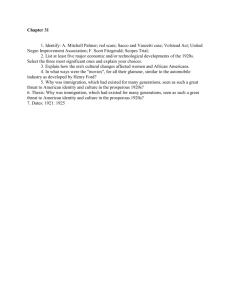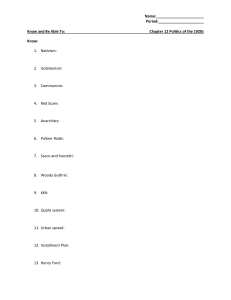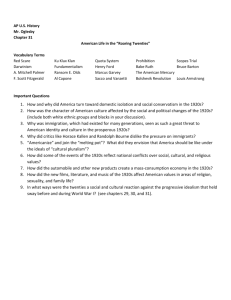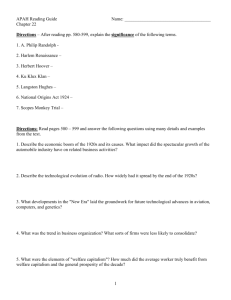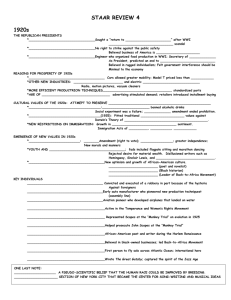Women`s Rights Women were granted the right to vote through the
advertisement
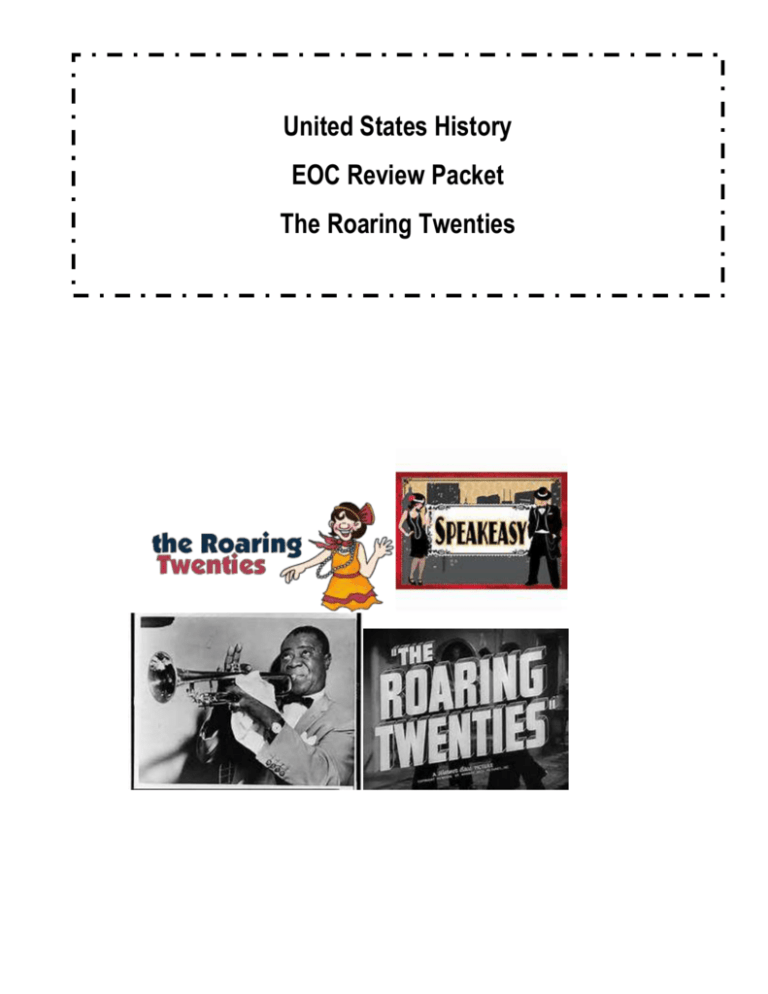
United States History EOC Review Packet The Roaring Twenties Women’s Rights o o o o Women were granted the right to vote through the 19th Amendment during the Progressive Era (1917) The national effort to ratify women’s suffrage (right to vote) was strengthened by the economic opportunities created by World War I because women had to perform the jobs of men while they were away at war Seneca Falls Convention: Susan B. Anthony, Carrie Chapman Catt, Elizabeth Cady Stanton and Lucretia Mott were major female leaders of the women’s rights movement Many of the western states granted women the right to vote before the adoption of the 19th Amendment because frontier (western) women played important roles in society Roaring Twenties The 1920s are called the Roaring Twenties because of widespread social and economic change and changing cultural values (social change). During the 1920s there was a conflict between old and new American ideas. Social Change Prohibition: law authorized by the 18th Amendment that banned the manufacture and sale of alcoholic beverages. o led to an increase in organized crime o respect for the law decreased o led to a public awareness that unpopular laws are difficult to enforce o Prohibition was officially ended by the 21st Amendment Increase of nativism can be illustrated by the Red Scare, trial of Sacco and Vanzetti and the activities of the Ku Klux Klan Immigration acts of the 1920s attempted to use quotas to limit immigration from southern and eastern Europe Sacco and Vanzetti: two immigrant anarchists who were convicted of murder and executed with very little evidence during the height of the Red Scare. Demonstrated US intolerance toward immigrants. Repressed a threat to civil liberties Scopes Trial: John Scopes was convicted in 1925 for teaching about evolution (because it conflicted with what the Bible says) o the conviction was supported by some Americans who wanted to promote traditional fundamentalist values (people who believe strictly in a set of principles and do not consider other views or opinions) o illustrated a conflict concerning religious beliefs and scientific theories o illustrated a larger conflict over cultural values in American society during the 1920s Harlem Renaissance: African American authors and artists used literature and art to celebrate the richness of their heritage. Increased pride in African American culture. Ex: Langston Hughes, Bessie Smith, Duke Ellington Flappers: women during the 1920s that rejected traditional feminine roles. Refused to conform to society’s expectations (they acted and dressed how they wanted to, not how society told them they should) Automobiles, radio and motion pictures standardized American culture (influenced what people considered to be “American culture”) Economic Change Henry Ford: use of the assembly line in the production of automobiles led directly to a decrease in the cost of automobiles Growth of the automobile industry changed the economy by stimulating the development of other new industries Development of many new consumer goods led to rapid economic growth during the 1920s The number of credit purchases increased (people bought on credit rather using cash) Emergence of a “consumer culture” because advertising and installment payments encourage buying Installment Buying: paying for something a little at a time rather than all at once Increase in consumer buying and spending A belief in never-ending prosperity (economic success) helped to promote heavy increases in stock speculation During the 1920s prevailing view of government’s role in the economy was that the government should interfere as little as possible President Warren G. Harding: called for “a return to normalcy” by advocating for reduced international involvement and less government regulation of business. Supported isolationism President Calvin Coolidge: believed the economy functions best if government allows business to operate freely (free enterprise system). Small farmers did not fare well during the Coolidge prosperity in the 1920s Overproduction of Farm Crops: demand for American farm goods dropped dramatically during the 1920s because European need for imported farm products declined after WWI. Owners of small family farms experienced the most severe economic problems during the 1920s Dust Bowl: caused by over-farming and severe drought. The Great Plains (flat farming center of the US) suffered most directly from the Dust Bowl. Resulted in increased westward migration (people in the Great Plains moved west in order to find a better living) Roaring Twenties Review Questions 1. The Red Scare, the National Origins Acts of the 1920s, and the verdict in the Sacco and Vanzetti trial are examples of negative American attitudes toward a. immigrants b. business leaders c. African Americans d. Labor union leaders 2. Which characteristic of the 1920s is illustrated by the trial of Sacco and Vanzetti? a. hostility toward woman’s suffrage b. support for segregation c. opposition to separation of church and state d. intolerance toward immigrants 3. During the 1920s, Congress passed a series of immigration laws that were primarily designed to a. increase immigration from Asia b. expand the workforce for the growing economy c. limit immigration from southern and eastern Europe d. prohibit immigration from Latin America 4. The influence of nativism during the 1920s is best illustrated by the a. increase in the popularity of the automobile b. emergence of the flappers c. expansion of trusts and monopolies d. growth of the Ku Klux Klan 5. A major goal of the immigration acts of the 1920s was to a. allow unlimited immigration from Southeast Asia b. assure equal numbers of immigrants from all nations c. favor wealthy and well-educated immigrants d. use quotas to limit immigration from southern and eastern Europe 6. During the 1920s, controversies concerning the Scopes trial, national Prohibition, and the behavior of “flappers” were all signs of disagreement over a. the return to normalcy b. traditional values and changing lifestyles c. causes of the Great Depression d. the benefits of new technology 7. The failure of national Prohibition led to a public awareness that a. crime rates decline when the sale of alcoholic beverages is banned b. economic prosperity encourages social conformity c. unpopular laws are difficult to enforce d. geographic conditions affect law enforcement 8. The national policy of Prohibition ended when the states a. strengthened food and drug laws b. legalized alcohol for medical purposes c. ratified the 21st amendment d. banned interstate shipment of alcoholic beverages 9. In 1920, women gained the right to vote as a result of a a. presidential order b. Supreme Court decision c. national election d. constitutional amendment 10. The Scopes trial of 1925 is an example of a. the effects of assimilation on American culture b. a clash between scientific ideas and religious beliefs c. an increase in violence in American society d. government intervention in racial conflicts 11. National Prohibition, as authorized by the 18th amendment, stated that a. Americans must be 18 years old to purchase alcoholic beverages b. only imported alcoholic beverages would be sold c. alcoholic beverages could be sold only in government run stores d. the manufacture and sale of alcoholic beverages was banned 12. Which event of the 1920s symbolized a conflict over cultural values? a. election of Herbert Hoover b. transatlantic flight of Charles Lindbergh c. Scopes trial d. stock market crash 13. The Scopes trial of the 1920s dealt with a conflict between a. communism and capitalism b. Protestants and Catholics c. science and religion d. labor and management 14. Langston Hughes & Duke Ellington are noted for their contributions to the cultural movement of the 1920s known as the a. Gospel of Wealth b. Lost Generation c. Harlem Renaissance d. Gilded Age 15. “Public Ignores Prohibition Restrictions” “Evolution and Creation Debated in Scopes Trial” “Women Bring Change to the Industrial Workforce” What do headlines such as these from the 1920s illustrate? a. conflict between traditional and modern values b. trend toward mass consumption of consumer goods c. hostility of certain groups toward ethnic minorities d. debate over the role of government in the economy 16. During the Harlem Renaissance of the 1920s, African American authors and artists used literature and art to a. end segregation of public facilities b. promote affirmative action programs c. celebrate the richness of their heritage d. urge voters to elect more African Americans to political office 17. The changing image of women during the 1920s was symbolized by the a. passage of an equal pay act b. drafting of women into the army c. popularity of the flappers and their style of dress d. appointment of several women to President Coolidge’s cabinet 18. The Harlem Renaissance promoted African American culture by a. increasing factory employment opportunities for minorities b. encouraging immigration from Africa c. focusing attention on artistic contributions d. bringing an end to legalized racial segregation 19. Which pair of events illustrates an accurate cause and effect relationship? a. Sacco and Vanzetti trial – ratification of the woman suffrage amendment b. rebirth of the KKK – formation of the Populist Party c. Red Scare – demand for limits on immigration d. high food prices – start of the Great Depression 20. The convictions of Sacco and Vanzetti in the 1920s most closely reflected the a. increase in nativist attitudes b. federal government’s war on crime c. corruption of political machines d. rise in labor unrest
